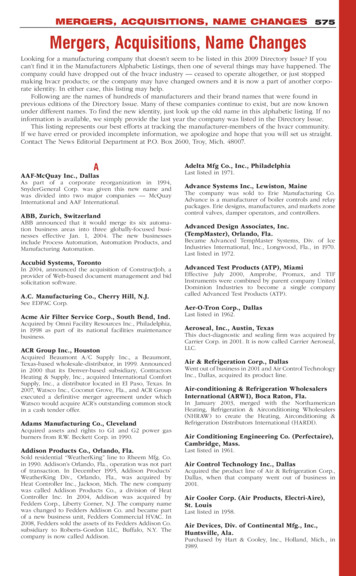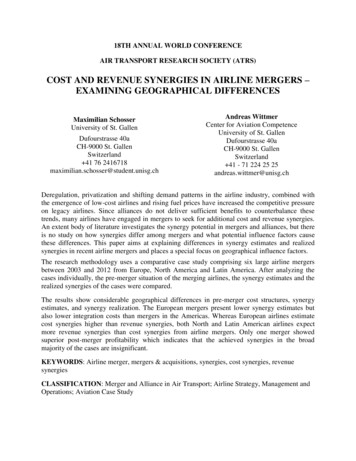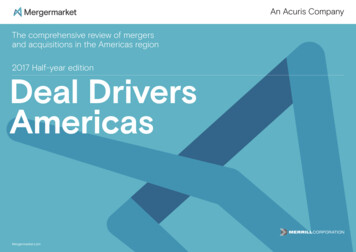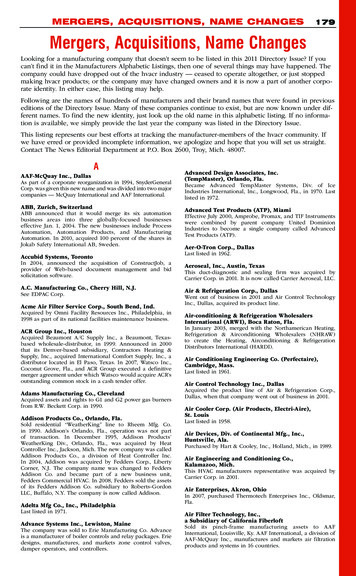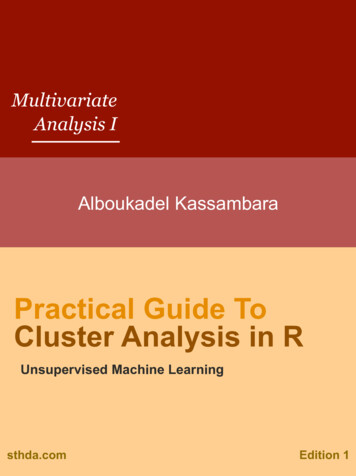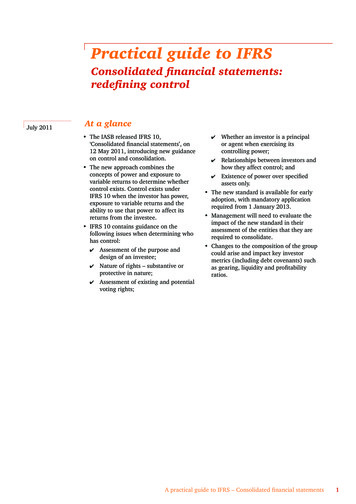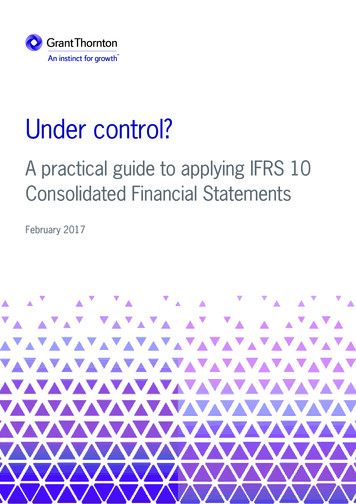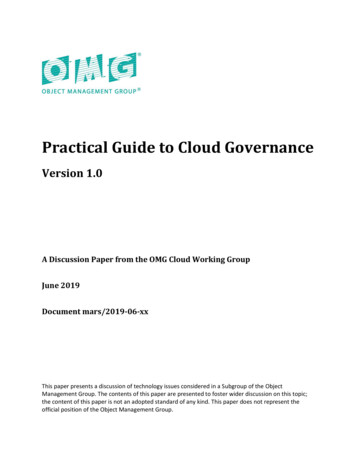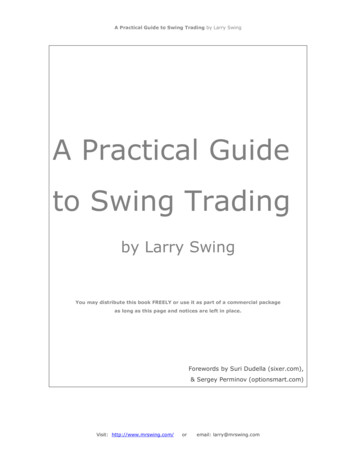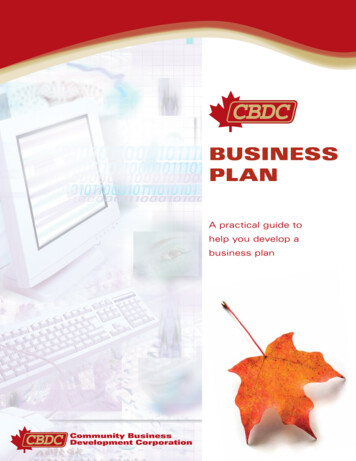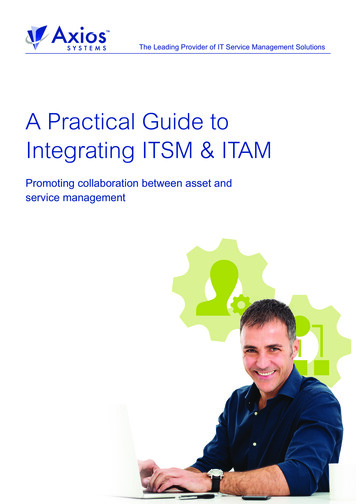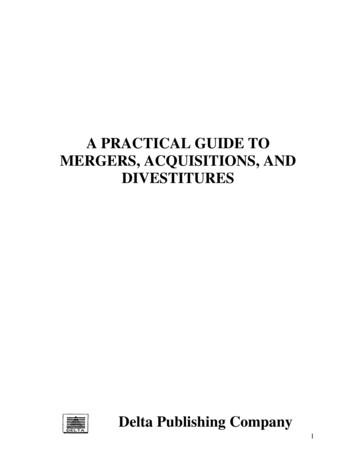
Transcription
A PRACTICAL GUIDE TOMERGERS, ACQUISITIONS, ANDDIVESTITURESDelta Publishing Company1
Copyright 2009byDELTA PUBLISHING COMPANYP.O. Box 5332, Los Alamitos, CA 90721-5332All rights reserved. No part of this course may bereproduced in any form or by any means, withoutpermission in writing from the publisher.2
TABLE OF CONTENTSCHAPTER 1MERGERS AND ACQUISITIONSCHAPTER 2DIVESTITUREGLOSSARY3
CHAPTER 1MERGERS AND ACQUISITIONSLEARNING OBJECTIVES:After studying this chapter you will be able to:1. Define mergers.2. List twelve conditions required to merge.3. Define and perform due diligence.4. Identify information to consider before "doing a deal”5. Describe antitrust guidelines6. Explain M & A percent rules.7. Plan for mergers and acquisitions.8. Decide on acquisition terms.9. List factors in determining a price.10. Describe grading criteria.11. Summarize acquisition strategy and process.12. Finance the merger.13. Use capital budgeting techniques for M&A analysis.14. Explain the effect of merger on earnings per share and Market price per share.15. Describe the risk of the acquisition.16. Explain the methods of hostile takeover bids.17. Outline SEC filing requirements and tax considerations18. Enumerate defensive measures by targeted company.19. Determine the value of a targeted company.20. Describe accounting, reporting and disclosures for business combinations21. Discuss the importance of corporate development officers (CDOs)—M&A teamsFor years, academic studies maintained mergers and acquisition (M&A) deals destroyedshareholder value. In 2006, however, businesses around the globe bought (and therefore sold)more companies for more money than ever. It was not just a year of record merger volume more than 3,800 billions - but also a merger market with unprecedented breadth, acrossgeographies and industries. M&A transactions in the current merger cycle differ in significantways from those of the 1990s, and this probably explains why so much value has recently beencreated. Specifically, this current merger boom is characterized by Horizontal consolidation with significant potential for cost synergies. The use by acquirers of existing cash and borrowed money (after-tax cost) topurchase the (relatively higher cost) equity of acquired companies. Much lower acquisition premiums being initially paid.Mergers and acquisitions can result in new organizations whose financial and strategicoptions are much improved. They are driven by globalization, a long-term market, variousbarriers to growth, which make M&As a valuable tool by which companies can quickly attemptto increase revenue.1
This chapter discusses all facets of M&As including deciding on terms, key factors toconsider, pros and cons of mergers, types of arrangements, evaluative criteria, valuationmethods, financial effects of the merger, holding companies, takeover bids, SEC filingrequirements, accounting and reporting requirements for business combinations, and financialanalysis of combinations.External growth occurs when a business purchases the existing assets of another entitythrough a merger. You are often required to appraise the suitability of a potential merger as wellas participate in negotiations. Besides the growth aspect, a merger may reduce risk throughdiversification. The three common ways of joining two or more companies are a merger,consolidation, or a holding company.In a merger, two or more companies are combined into one, where only the acquiringcompany retains its identity. Generally, the larger of the two companies is the acquirer. Amerger is a business combination in which the acquiring firm absorbs a second firm, and theacquiring firm remains in business as a combination of the two merged firms. The acquiring firmusually maintains its name and identity. Mergers are legally straightforward because there isusually a single bidder and payment is made primarily with stock. The shareholders of eachmerging firm involved are required to vote to approve the merger. However, merger of theoperations of two firms may ultimately result from an acquisition of stock.With a consolidation, two or more companies combine to create a new company. Noneof the consolidation firms legally survive. For example, companies A and B give all their assets,liabilities, and stock to the new company, C, in return for C’s stock, bonds, or cash.A holding company possesses voting control of one or more other companies. Theholding company comprises a group of businesses, each operating as a separate entity. Bypossessing more than 50% of the voting rights through common stock, the holding company haseffective control of another company with a smaller percent of ownership.Depending on the intent of the combination, there are three common ways in whichbusinesses get together so as to obtain advantages in their markets. They are: Vertical merger. This occurs when a company combines with a supplier or customer.An example is when a wholesaler combines with retailers.Horizontal merger. This occurs when two companies in a similar business combine.An example is the combining of two airlines.Conglomerate merger. This occurs when two companies in unrelated industriescombine, such as where an electronics company joins with an insurance company.MERGERSOutstanding planning and execution are essential for a successful merger. Integration isreached only after mapping the process and issues of the companies to be merged. Even thenjust 23% of all acquisitions earn their cost of capital. When M&A deals are announced, acompany’s stock price rises only 30% of the time. In acquired companies, 47% of executivesleave within the first year, and 75% leave within the first three years. Synergies projected for2
M&A deals are not achieved 70% of the time. Productivity of merged companies can beaffected by up to 50% in the first year and financial performance of newly merged companies isoften lacking.While there is no set formula to guarantee a successful merger, in order to minimize thenegative impacts previously discussed, a map of M&A process and issues should be developed.The following steps describe the model of process and issues:Step 1: FormulateThis stage involves the organization setting out its business objectives and growthstrategy in a clear, rational, and data-oriented way. Companies should avoid vague and generalobjectives. Instead, a specific criteria should be formulated based on the objectives that havebeen determined and on a strategy of growth through acquisition. These criteria should beexpressed in terms of goals like market share, geographic access, new products or technologies,and general amounts for financial synergy. The organization should evaluate the ideal targetcompany based on factors such as the following: What type of cost structure does the ideal target have?What market channels would this target provide?What kinds of organizational competence and capabilities would provide maximumleverage and the greatest number of synergies?Are there strategic customer accounts or market segments to be gained?In what global regions or countries can we build additional capacity through this target?What is the optimum capital structure?What are the sources for new acquisitions?Will the ideal targets be operated as independent holdings, or does the organizationintend to integrate the business partly or fully into its operations?If joint venture structures are to be used what level of involvement is desired by theparent company?Step 2: LocateAfter the strategic template has been set in Step 1, the search for desirable targetcompanies should become more focused on financing an operational analysis. These initialparameters, terms, and conditions are defined and ultimately submitted as part of a letter ofintent. These letters describe the desired objectives and give an overview of the proposedfinancial and operational aspects of the transaction. They also include specific details on itemslike the assets and business units involved, the equity positions of the parent companies, theassumption-of-debt requirements, inter-company supply agreements, employee liabilities, taxes,technology transfer, indemnification, public announcements, and other essential terms andconditions. Additional agreements outside the letter of intent should be made about thefollowing issues. In the case of a joint venture arrangement, the governance structure of thepartnership and specific issues for approval need to be agreed upon. The overall process to beused for determining top-level organizational structure and staffing decisions should also beagreed upon. Agreement on the integration process to be used, including mutual participation,formation of key task forces, planning phases, and leadership roles should take place at thispoint. Another additional agreement that should be made at this point is high-level reconciliation3
of major discrepancies regarding executive compensation, employee benefits, and incentivecompensation plans. Once a consensus is made regarding these agreements, companies canmove to Step 3.Step 3: InvestigateThe third step in the model relies on exploring all facets of the target company beforefinalizing a definitive agreement. Due diligence must be exercised in the financial, operational,legal, environmental, cultural, and strategic areas. Key findings should be summarized forexecutive review, and all potential merger problems should be identified. Due diligence findingsare used to set negotiating parameters, determine bid prices, and provide the basis for initialintegration recommendations.Due diligence is particularly important in light of recent felonious accounting practices.Had Enron or WorldCom been acquired without due diligence, the newly formed companywould probably not have uncovered accounting irregularities until months after the acquisition.This could cost billions in market capitalization. There are other areas where due diligence ishelpful with assessing risk. The following are key areas to focus due diligence. Market. How large is the target’s market? How fast are specific segments growing?Are there threats from substitute technologies or products? To what extent is themarket influenced or controlled by governments?Customers. Who are the target’s major customers? What are their purchase criteria:price? Quality? Reliability? Do buyers of product X also buy product Y, and dothey buy both through similar channels? Are there unmet needs? Are changes inbuying behavior to be expected?Competitors. Who are the target’s major competitors? What is the degree of rivalry?What are the competitor’s strengths and weaknesses? What barriers to entry exist fornew competitors? How will the competitors try to exploit the merger or integrationissues to their own advantage?Culture and human resources. Which key people must be kept, which core areas ofcompetence should be retained, and how possible is it to do either? Are there majorcultural discrepancies with the target? If they could cause major defections or otherlosses of productivity, is the organization willing to resolve them? If so, at what cost?To be uninformed on any of these issues can prove to be just as costly as the discovery offraudulent accounting practices. This level of detailed evaluation must be conducted before anexecutive team can properly recognize the level of integration that will be appropriate to supportthe deal.Exhibit 1 provides a checklist for due diligence.EXHIBIT 1DUE DILIGENCEINFORMATION TO CONSIDER BEFORE "DOING A DEAL”Financial4
.21.22.23.24.25.26.27.Latest audited financial statements.Last unaudited financial statements.Ten-year summary financial statements. (Product P&L essential if more than one product.)Projected operating and financial statements.Full description of securities, indebtedness, investments, and other assets and liabilities otherthan normal day-to-day accounts.Trial balance and chart of accounts and/or description of accounting practices relative toinventories, fixed assets, reserve accounts, etc.List of bank accounts, average balances.Credit reports from banks and Dun & Bradstreet.Federal income tax status; i.e., tax credits, loss or unused carry forwards, any deficiencyclaims, etc.Summary of state and local tax situation; i.e., applicable taxes, unemployment tax rate,deficiency claims, etc.Tax status of proposed transaction; recommendation of best method of acquisition.Complete list of insurance policies, including description of coverage and cost: workmen'scompensation rate.Statement of responsible officer of business as to unrecorded or contingency liabilities.Statement of inventories.Compare last two physical inventories of sizable money items to reflect slow-moving andobsolete materials. Note finished products particularly. Determine how physicalcompared with book at last physical inventory.Aged list of accounts receivable, credit and collection policies, and trial balance ofaccounts payable.Detailed statement of general and administrative expenses, selling expenses, factoryoverhead on a comparative basis for three years.Status of re-negotiation and price re-determination.Bonus and pension plans; salary and commission contracts.Statement of unfilled orders-present and past.Statistics regarding industry group (trends, return on investment, margin on sales, etc.)If any defense contracts in backlog, check margin of profit. Also, if any existingequipment is government-owned.Statements regarding company's break-even point, including details of product mix, costs,and fixed and variable expenses.Status of production or other contracts requiring company performance for a fixed amountwhere work is yet to be accomplished.List of outstanding capital-asset items.Status of patents, copyrights, royalty agreements, etc.Details of corporate equity accounts.OperationsProduction1. Review Estimating Department Procedure and formula used for computing cost toestablish sales prices. Also review record of performance versus existing sales prices todetermine if all items show a profit. Determine if sales prices are actually based on costsor fixed and influenced by competition without regard to cost.5
2. Appraise key production personnel, also constructions and age of buildings, noting thoseequipped with overhead cranes.3. Determine if any improvements are planned and authorized, of if any were recentlypresented and disapproved.4. Review planning and scheduling procedures.5. Make casual inspection of property, plant, and equipment and note their condition.Determine age of machinery and if of reputable make.6. Determine if production employees paid day-work exclusively, or both day-work andpiece work, or if some other means of incentive is employed. If other than day-work payis employed, obtain procedure and any formulas used in establishing the incentive.7. Determine method of inspection employed.8. Determine if all power is purchased, manufactured, or combinations of both.9. Obtain general history of plant growth and rearrangements as far back as possible.10. Check intrinsic value of patents and (if any) royalty paid on any products or partsproduced.11. Review past overhead charges and obtain explanation of the larger charges.12. Obtain copies of the following:a.b.c.d.e.f.g.h.i.j.k.l.Plant plans and flow-chartsProduce list, catalogues, or circularsProduction schedules and forecastsLabor contractsCommitmentsList of machinery, equipment, fixtures and furnitureOrganization chartLabor utilization reportsEquipment utilization reportsProduction reportsMinutes of meetingsStandard cost data13. Examine union contracts, paying attention to any prior negotiations that are apt to reoccur.14. Check out labor supply in various geographical areas impacted by company.Industrial Relations1. How many employees currently work for the company and what are the employee trends inprior year?2. What is the labor turnover and what was the labor turnover trend for prior years?"3. What is the absentee rate?"4. Is the company unionized? How long? Contracts?5. What is the labor dispute history?6. Is the relationship between the company and employees friendly? Between the companyand union?7. Scope of Industrial Relations Department responsibilities8. What executives participate in negotiations?9. What procedures exist for:6
10.11.12.13.14.a. Hiringb. Firingc. PromotionWhat percentage of promotions comes from within?What types of training programs exist? Is there a training department? Training Director?Is there an active safety program?How are pay rates determined?How are fringe benefits determined?Engineering and Research1. Description and condition of facilities2. To whom does the head of the Engineering Department report?3. Is there a policy manual?4. What are the short-range and long-range objectives?5. Obtain department budget.6. Determine employee turnover.7. What is the source of engineering employees?8. Who owns product designs, patents, copyrights, etc.?Purchasing1. Make complete analysis of inventory supply.2. Determine existence of contracts and/or agreements for materials or outside services whichare obligations that would have to be assumed.3. Determine existence of a supplier's equipment or facilities on company property for whichresponsibility would have to be assumed.4. Review the details of inventory including the following:a. Method, accuracy, and date of prices usedb. Compare with current pricesc. Evaluate inventory on basis of what material would bring on an open marketd. Determine if material is used currently. Make certain that it is not obsolete and/oractually not usable.5. Review the present employees in the Purchasing Department as to:a. Number of employeesb. Experiencec. Abilityd. Personal habits6. Review the functions of the Purchasing Department including:a. Policiesb. Proceduresc. RecordsLegal1. Does the seller have power to do the acts the deal requires?a.b.Legal power: SEC, state corporate laws, "Blue Sky" laws, etc.Corporate power: charter, bylaws, etc.7
c.Contractual power: restriction in bank loan agreements, etc.2.3.Does risk exist that seller's shareholders will attack deal as a merger, etc.?Does risk of attack by creditors exist? Review need for compliance with Bulk Sales Act inan asset deal.4. Is seller’s corporation in good standing and qualified in all states in which its businessrequires same?5. Is a voting trust needed?6. If seller was organized within five years, determine names of promoters, nature of anamount of anything of value (including money, property, options, etc.) received or to bereceived by each promoter directly and indirectly.7. Is there a material relationship between buyer (or any of its officers and directors) andseller (or any of its officer and directors)?8. Will seller indemnify buyer against business brokers' and finders' fee?9. Would the acquisition invite antitrust investigation or prosecution?10. Are seller's beneficial contracts assignable?a. Licenses and royalty agreementsb. Employment agreementsc. Leasesd. Suppliers' contractse. Customers' contracts, particularly U.S. Governmentf. Collective-bargaining agreements11. Are any of its beneficial contracts already subject to prior assignments - e.g. to lendinginstitutions?12. Are there customs or contracts which would place an obligation or duty on buyer in eithera stock or an asset deal?a. Profit sharing plansb. Contributory employee stock-purchase or savings plansc. Restricted stock-option plansd. Pension and bonus planse. Pattern of traditionally high salaries and fringe benefitsf. Group insurance and similar employee benefit plansg. Check also 10a, b, c, d, e, and f13. Obtain brief description of location and general character of principal plants and officers.If any such property is not owned or is held subject to a major encumbrance, so state andbriefly describe how held (consider lease termination dates and powers to renew). Check:a. Liens for tax assessmentsb. Liens a/c partial payments, etc. on government contractse. Restrictions, such as zoning, on use of real property and easements14. Are all required federal and state tax returns filed, examined, and settled?a. Income and excess-profits taxesb. Franchise and capital stock taxesc. Sales and use taxesd. Real- and personal-property taxese. Other excise taxes15. Determine adequacy of all established reserves.16. Examine re-negotiation procedures, settlements, and reserves.8
17. Determine whether contracts with customers have re-determination clauses and minimum netexposure thereunder.18. Determine whether contracts with suppliers and customers have escalation clauses andmaximum net exposure thereunder.19. How secure are seller's property rights in its:a. Patentsb. Trademarks, trade names, and copyrightsc. Goodwill20. Is seller party to any unusual "confidential treatment" or "secret " agreements?21. Does seller maintain adequate insurance on all insurable property and all reasonable risk? Ifnot, has any significant event occurred with respect to an uninsured property or risk?22. Review warranties to customers, particularly warranties of design. Determine whetherreserves have been established and review history.23. Does selling company presently have requisite amount of general and specialized legalcounsel? Can or should they be continued or changed?24. Will goodwill or other intangibles result from the transaction? Will the transaction producethe anticipated accounting result? Are any appraisers required?25. Does seller have benefits under any contracts or other arrangements which would terminateor increase in cost following acquisition?26. Will transaction result in any minority stockholders, or provide dissenting stockholders withany appraisal rights?Marketing1. Description of product line and brief company history.2. Does the product line of subject company have anything in common with the linesproduced by existing divisions of the buyer?3. Ten-year record of the company's product sales performance and methods of distribution.4. What reputation does the company enjoy among its customers?5. Check the consistency of production covering the last three to five years for seasonaltrends or diminishing demand for any products.6. Long-range forecast of growth or contraction trends for this industry. What are theprospects of substitute materials, processes, or products?7. Who are the customers? What is the long-range outlook for the future business of thesecustomers?8. Three- to five-year forecast of demand for the product, and estimate of industry's ability tosupply.9. An evaluation of the company's three- to five-year forecast of sales expectations (share ofmarket).10. Present competitors:a. Description of competitive productsb. Location and size of plantsc. Share of marketd. Pricing policiese. Methods of distributionf. Reputation and financial details9
11. Analysis of past price trends and policies and present or future pricing policies for theproduction line, considering:a. Competitive pricingb. Cost pricing12. Analysis of present and potential customers:a. Major types of customers and percentage of sales to eachb. Geographical locationc. Buying habits13. Analysis-location of plant:a. Competitive accessibility to major marketsb. Distribution costs14. Review and evaluate Sales Department:a.Sales managementb.Organization and operating proceduresc.Field sales force-compensation, turnover rate, sales trainingd.Sales policies15. Review and evaluate advertising and promotion programs and policies:a. Objectives and techniques of the advertising programb. Analysis of principal elements of advertising budgetc. Appraisal of advertising organization, personnel, and agency relationshipsd. Comparison of techniques and program with those of major competitorsOrganization1. Does the company have an organization chart?a.Is it maintained currently?b.Does it properly reflect the assigned functions?2. Does the company have an organization manual which maintains organization charts and jobdescriptions?a. Is it maintained up to date?b. Do the job specifications properly reflect the jurisdiction, authority, and responsibilityof the job?3. Does the company have a policy manual containing the president's policy statements and thewritten interpretations of policy issued by the officers, executives, and general management?4. Is there a program which is actively pursued to train and develop outstanding employees formanagement and executive positions?5. Is there a program of individual executive ratings on an annual basis? If so, review theratings pertaining to key personnel.6. Does the company maintain an education program for its employees?a. What are the annual costs?b. What percentage of the employees participates in the program?7. Does the company maintain a scholarship program? What are the annual costs?8. Review the salary rates of key personnel.Public Relations1. Does the company have a Public Relations Department? Is it properly staffed? To whomdoes the public relations director, or the person responsible for the function, report?10
2. Does the company have a planned public relations program? Does the program encompassthe major public, including:a. Pressb. Stockholdersc. Financial communityd. Plant communitiese. Employeesf. Customers3. How does the above-mentioned public consider the company?4. Does the company have an institutional advertising campaign?5. Does the company employ outside public relations consultants?6. Will the acquisition of the company be a public relations asset to the buyer?Step 4: NegotiateThis step includes requirements for successfully reaching a definitive agreement. Dealteams should be briefed by due diligence teams, who together with executives should formulatethe final negotiating strategy for all terms and conditions of the deal. Considerations includeprice, performance, people, legal protection, and governance.Step 5: IntegrateThe last step of the model should be customized to each organization and adapted to eachspecific deal. This is the actual process of planning and implementing the newly formedorganization with its processes, people, technology, and systems. In determining how to resolvethe issues that arise at this stage, the merging organizations must carefully consider suchquestions as how fast to integrate, how much disruption will be created, how disruption can beminimized, how people can be helped to continue focusing on customers, safety, and day-to-dayoperations, and how to best communicate with all the stakeholder groups of the company.Exhibit 2 outlines the previously discussed Watson Wyatt Deal Flow and the processesand issues involved.11
EXHBIT 2MAP OF M&A PROCESSES AND ISSUESFormulateKeyActivitiesIssuesRisks Set businessstrategy Set growthstrategyLocate Identify targetmarkets andcompanies Select target Set deal terms:1. Legal2. Structural3. Financial Secure key talentand integrationteams Finding summary Close deal Set preliminaryintegration plans Decide negotiationparametersROI/ Value Strategic Fit Cultural Fit TimingLeadership Fit Potential synergy Viability LiabilitiesHuman Capitalretention/eliminate PricePerformancePeopleProtectionGovernanceDefine acquisition criteriaIssue letter ofIntent Begin strategyimplementation Develop M&APlan Offer letter ustomersCountriesCapitalCapacity NegotiateDue diligenceanalysis:1. Financial2. People/Culture3. Legal4. Environmental5. Operational6. Capitals Investigate Financial ViabilityIntegration IssuesSynergiesEconomy of scaleROIIntegrate Finalize andexecuteintegration plans:1. Organization2. Process3. People4. Systems SpeedDisruptionCostsRevenuesResultsPerception:1. Shareholders2. Public3. Customers4. EmployeesPROS AND CONS OF A MERGERThere are many reasons why your company may prefer external growth through mergersinstead of internal growth.Advantages of a Merger Increases corporate power and improves market share and product lines. Aids in diversification, such as reducing cyclical and operational effects. Helps the company’s ability to raise financing when it merges with another entity havingsignificant liquid assets and low debt.12
Provides a good return on investment when the market value of the acquired business issignificantly less than its replacement cost. Studies suggest that the shareholders of targetfirms that are acquired receive the greatest benefit.Improves the market price of stock in some cases, resulting in a higher P/E ratio. Forexample, the stock of a larger company may be viewed as more marketable, secure, andstable.Provides a missed attribute; that is, a company gains something it lacked. For instance,superior management quality or research capability may be obtained.Aids the company in financing an acquisition that would not otherwise be possible to obtain,such as where acquiring a company by exchanging stock is less costly than building newcapital facilities, which would require an enormous cash outlay. For instance, a companymay be unable to finance significant internal expansion but can achieve it by purchasing abusiness already possessing such capital facilities.Achieves a synergistic effect, which means that the results of the combination are greaterthan the sum of the parts. For instance, greater profit may result from the combined entitythat would occur from each individual company due to increased efficiency (e.g., economiesof scale) and cost savings (e.g., eliminating overlapping administrative functions, volumediscounts on purchases). There is better use of people and resources. A greater probabilityof synergy exists with a horizontal merger since duplicate facilities are eliminated.Operational synergy arises because the combined firm may be able to increase its revenuesand reduce its costs. For example, the new firm created by a horizontal merger may have amore balanced prod
2. List twelve conditions required to merge. 3. Define and perform due diligence. 4. Identify information to consider before "doing a deal” 5. Describe antitrust guidelines 6. Explain M & A percent rules. 7. Plan for mergers and acquisitions. 8. Decide on acquisition terms. 9. List factors
